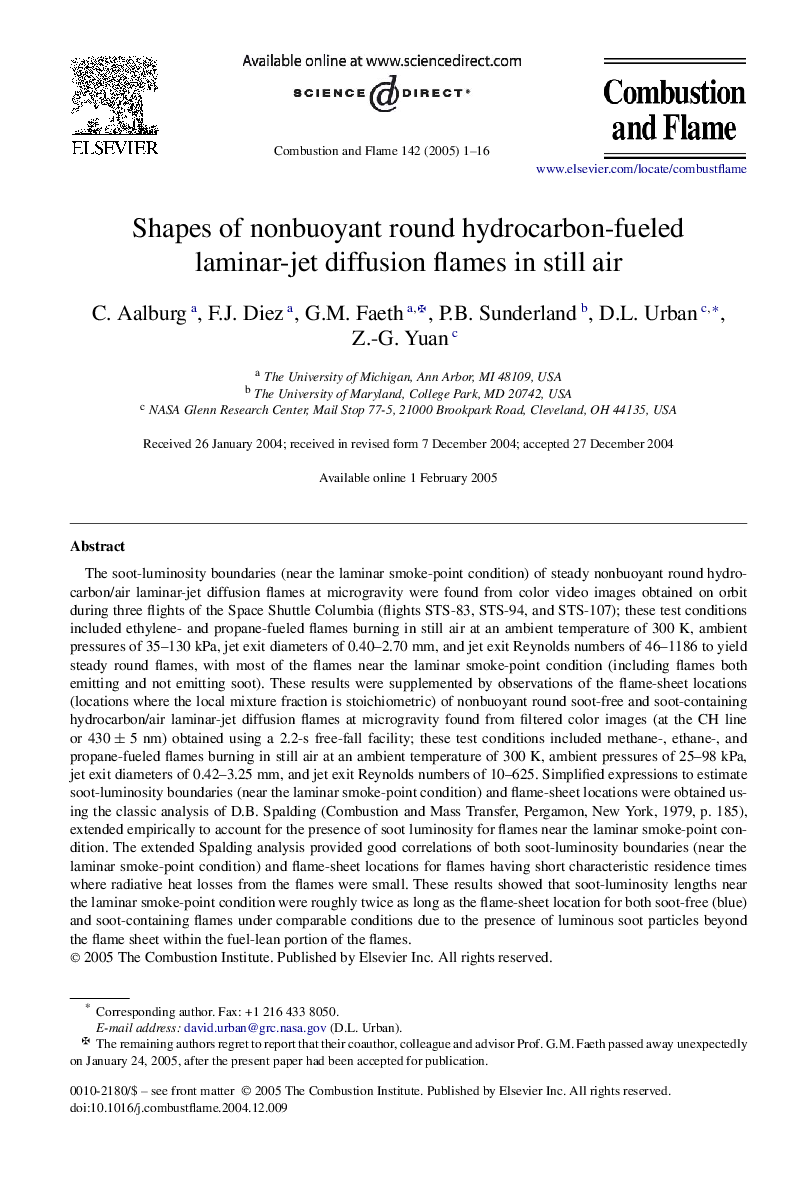| کد مقاله | کد نشریه | سال انتشار | مقاله انگلیسی | نسخه تمام متن |
|---|---|---|---|---|
| 9624500 | 458097 | 2005 | 16 صفحه PDF | دانلود رایگان |
عنوان انگلیسی مقاله ISI
Shapes of nonbuoyant round hydrocarbon-fueled laminar-jet diffusion flames in still air
دانلود مقاله + سفارش ترجمه
دانلود مقاله ISI انگلیسی
رایگان برای ایرانیان
کلمات کلیدی
موضوعات مرتبط
مهندسی و علوم پایه
مهندسی شیمی
مهندسی شیمی (عمومی)
پیش نمایش صفحه اول مقاله

چکیده انگلیسی
The soot-luminosity boundaries (near the laminar smoke-point condition) of steady nonbuoyant round hydrocarbon/air laminar-jet diffusion flames at microgravity were found from color video images obtained on orbit during three flights of the Space Shuttle Columbia (flights STS-83, STS-94, and STS-107); these test conditions included ethylene- and propane-fueled flames burning in still air at an ambient temperature of 300 K, ambient pressures of 35-130 kPa, jet exit diameters of 0.40-2.70 mm, and jet exit Reynolds numbers of 46-1186 to yield steady round flames, with most of the flames near the laminar smoke-point condition (including flames both emitting and not emitting soot). These results were supplemented by observations of the flame-sheet locations (locations where the local mixture fraction is stoichiometric) of nonbuoyant round soot-free and soot-containing hydrocarbon/air laminar-jet diffusion flames at microgravity found from filtered color images (at the CH line or 430±5nm) obtained using a 2.2-s free-fall facility; these test conditions included methane-, ethane-, and propane-fueled flames burning in still air at an ambient temperature of 300 K, ambient pressures of 25-98 kPa, jet exit diameters of 0.42-3.25 mm, and jet exit Reynolds numbers of 10-625. Simplified expressions to estimate soot-luminosity boundaries (near the laminar smoke-point condition) and flame-sheet locations were obtained using the classic analysis of D.B. Spalding (Combustion and Mass Transfer, Pergamon, New York, 1979, p. 185), extended empirically to account for the presence of soot luminosity for flames near the laminar smoke-point condition. The extended Spalding analysis provided good correlations of both soot-luminosity boundaries (near the laminar smoke-point condition) and flame-sheet locations for flames having short characteristic residence times where radiative heat losses from the flames were small. These results showed that soot-luminosity lengths near the laminar smoke-point condition were roughly twice as long as the flame-sheet location for both soot-free (blue) and soot-containing flames under comparable conditions due to the presence of luminous soot particles beyond the flame sheet within the fuel-lean portion of the flames.
ناشر
Database: Elsevier - ScienceDirect (ساینس دایرکت)
Journal: Combustion and Flame - Volume 142, Issues 1â2, July 2005, Pages 1-16
Journal: Combustion and Flame - Volume 142, Issues 1â2, July 2005, Pages 1-16
نویسندگان
C. Aalburg, F.J. Diez, G.M. Faeth, P.B. Sunderland, D.L. Urban, Z.-G. Yuan,